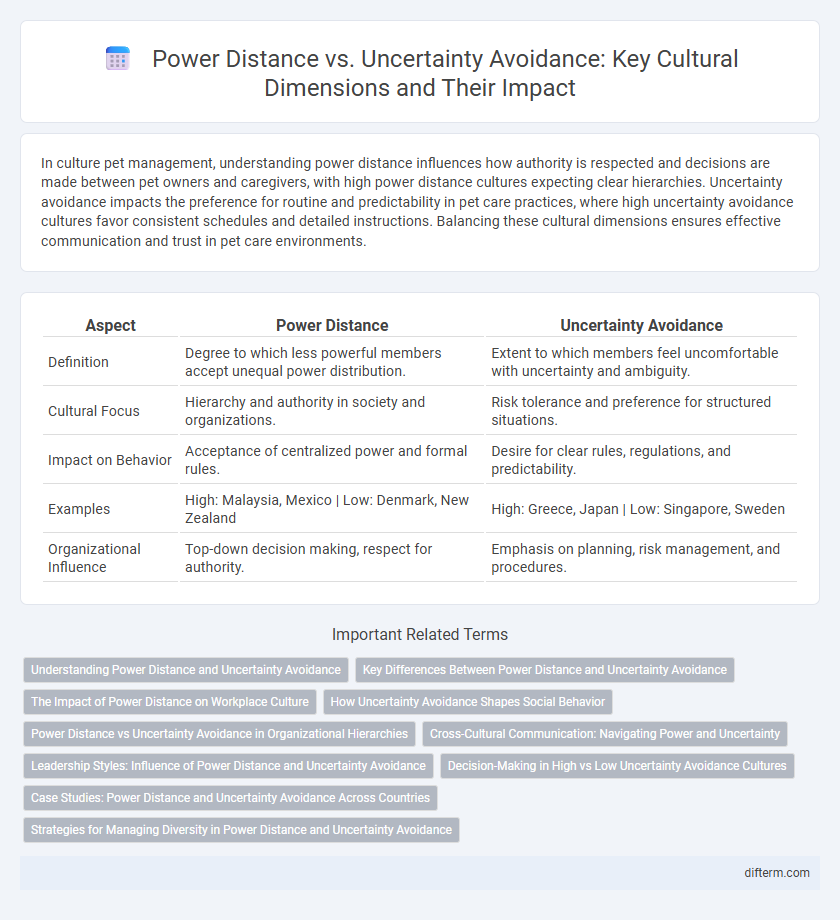In culture pet management, understanding power distance influences how authority is respected and decisions are made between pet owners and caregivers, with high power distance cultures expecting clear hierarchies. Uncertainty avoidance impacts the preference for routine and predictability in pet care practices, where high uncertainty avoidance cultures favor consistent schedules and detailed instructions. Balancing these cultural dimensions ensures effective communication and trust in pet care environments.
Table of Comparison
| Aspect | Power Distance | Uncertainty Avoidance |
|---|---|---|
| Definition | Degree to which less powerful members accept unequal power distribution. | Extent to which members feel uncomfortable with uncertainty and ambiguity. |
| Cultural Focus | Hierarchy and authority in society and organizations. | Risk tolerance and preference for structured situations. |
| Impact on Behavior | Acceptance of centralized power and formal rules. | Desire for clear rules, regulations, and predictability. |
| Examples | High: Malaysia, Mexico | Low: Denmark, New Zealand | High: Greece, Japan | Low: Singapore, Sweden |
| Organizational Influence | Top-down decision making, respect for authority. | Emphasis on planning, risk management, and procedures. |
Understanding Power Distance and Uncertainty Avoidance
Power distance measures how much less powerful members of a society accept unequal power distribution, influencing organizational hierarchy and communication styles. Uncertainty avoidance reflects a culture's tolerance for ambiguity and risk, affecting decision-making processes and innovation levels. Understanding these dimensions helps navigate cultural differences in leadership and workplace behavior.
Key Differences Between Power Distance and Uncertainty Avoidance
Power distance measures the extent to which less powerful members of a society accept hierarchical order and inequality, while uncertainty avoidance reflects a culture's tolerance for ambiguity and unstructured situations. High power distance cultures emphasize clear authority lines and centralized decision-making, contrasting with low power distance societies that promote equality and decentralized power. In contrast, high uncertainty avoidance cultures prefer strict rules, formal procedures, and predictability, whereas low uncertainty avoidance cultures embrace flexibility, innovation, and risk-taking.
The Impact of Power Distance on Workplace Culture
High power distance in workplace culture often leads to centralized decision-making and clear hierarchical structures, affecting communication flow and employee autonomy. Organizations with low power distance promote open dialogue and egalitarian relationships, enhancing collaboration and innovation. The level of power distance significantly influences management styles, employee engagement, and conflict resolution approaches within companies.
How Uncertainty Avoidance Shapes Social Behavior
Uncertainty avoidance directly influences social behavior by determining the degree to which individuals prefer structured environments and clear rules to minimize ambiguity in daily interactions. Cultures with high uncertainty avoidance typically exhibit rigid social norms, extensive rituals, and resistance to change, fostering tight-knit communities that emphasize predictability and security. In contrast, societies with low uncertainty avoidance embrace flexibility, tolerate ambiguity, and encourage innovation, leading to more open and diverse social practices.
Power Distance vs Uncertainty Avoidance in Organizational Hierarchies
Power Distance influences the acceptance of hierarchical authority within organizations, dictating the extent to which subordinates expect and accept unequal power distribution. Uncertainty Avoidance governs how organizations manage ambiguity and risk, shaping policies that reduce unpredictability and increase job security. In organizational hierarchies, high Power Distance often results in centralized decision-making, while high Uncertainty Avoidance promotes formal rules and procedures to minimize uncertainty.
Cross-Cultural Communication: Navigating Power and Uncertainty
Effective cross-cultural communication requires understanding the interplay between power distance and uncertainty avoidance to navigate hierarchical relationships and ambiguity tolerance. Cultures with high power distance accept unequal power distribution, influencing communication styles and decision-making authority, while high uncertainty avoidance cultures prefer structured environments and clear rules to reduce ambiguity. Mastering these cultural dimensions enhances adaptability and fosters respectful, clear exchanges across diverse organizational and social settings.
Leadership Styles: Influence of Power Distance and Uncertainty Avoidance
Leadership styles are distinctly shaped by cultural dimensions such as power distance and uncertainty avoidance. High power distance cultures often exhibit hierarchical leadership with centralized decision-making, while low power distance encourages participative and egalitarian management practices. Conversely, strong uncertainty avoidance fosters structured leadership with clear rules and risk-averse strategies, whereas cultures with low uncertainty avoidance prefer flexible, innovative approaches to leadership challenges.
Decision-Making in High vs Low Uncertainty Avoidance Cultures
High uncertainty avoidance cultures tend to rely on structured decision-making processes with clear rules and procedures to minimize ambiguity. In contrast, low uncertainty avoidance cultures prefer flexible, adaptive decision-making, embracing risk and uncertainty as opportunities for innovation. Power distance influences this dynamic by shaping who makes decisions and how much input subordinates have in the process.
Case Studies: Power Distance and Uncertainty Avoidance Across Countries
Case studies on power distance and uncertainty avoidance reveal significant cultural variations impacting organizational behavior and communication. For example, countries like Malaysia exhibit high power distance with centralized decision-making and hierarchical respect, while Sweden demonstrates low power distance promoting equality and participative management. In contrast, Japan scores high on uncertainty avoidance, emphasizing structured procedures and risk aversion, whereas the United States shows lower uncertainty avoidance, favoring innovation and entrepreneurial risk-taking.
Strategies for Managing Diversity in Power Distance and Uncertainty Avoidance
Effective strategies for managing diversity in cultures with high power distance emphasize clear hierarchical communication and respect for authority to reduce misunderstandings. In societies with high uncertainty avoidance, organizations implement structured protocols and risk mitigation practices to create a stable environment for diverse teams. Combining these approaches fosters inclusive workplaces that accommodate varying tolerance levels for hierarchy and ambiguity.
power distance vs uncertainty avoidance Infographic

 difterm.com
difterm.com